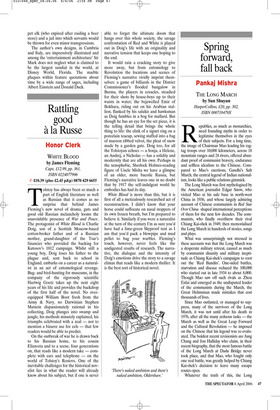Harnessing the horses of Apollo
Hugh Massingberd
SUNDIALS: HISTORY, ART, PEOPLE, SCIENCE by Mark Lennox-Boyd Frances Lincoln, £30, pp. 144, ISBN 0711224940 ✆ £24 (plus £2.45 p&p) 0870 429 6655 In my ignorance, before reading this most instructive, entertaining and beautifully produced book, I had idly regarded sundials as agreeable garden ornaments with little or no practical purpose. To quote Hilaire Belloc, ‘I am a sundial and I make a botch / Of what is done much better by a watch’. Yet our expert guide to the subject, Sir Mark Lennox-Boyd, a former Tory politician who is now Patron of the British Sundial Society and a prolific designer of sundials, is having none of this. Echoing Professor Joad of The Brains Trust, he counters Belloc’s couplet with ‘it all depends on how you measure time’. He suggests that ‘you could just as easily say that sundials tell the right time but clocks do not’.
Sir Mark does concede, though, that after Greenwich time pips began to be transmitted in 1924 sundials began to decay: ‘The dial had gone down-market and was more often than not a companion to the garden gnome.’ But more recently there has been a renewal of interest in the design of dials. They are evidently flourishing once more as finely crafted symbols of the passing of time. Sir Mark argues persuasively that sundials are the oldest of scientific instruments: ‘Their beauty is often a reflection of great craftsmanship, as well as a design statement which is highly ordered and rational.’ As for the common misconception that sundials are merely garden ornaments, Sir Mark traces its origins to the Renaissance, when men of learning developed the idea that the garden should be an area for the demonstration of the sciences. To emphasise his point, he only includes one conventional garden dial among the copious illustrations, for of ‘the many hundreds of thousands made since the Renaissance, only a few have been designed for gardens’.
Today we tend to forget that people used sundials as everyday objects. Indeed it wasn’t until I read the author’s simple statement that ‘before clocks, they were the only way of telling the time’ that I remembered the Round the Horne sketch about a Roman wage-slave ‘sundialling in at IX and sundialling out at half-past V’. Please don’t be put off by the dread word ‘Science’ in the subtitle. No one could be more scared of the subject than myself, yet as a contemporary lady said of one of the Georgian astronomer James Ferguson’s publications, ‘A child of ten years may understand it perfectly from one end to the other.’ The mathematics, I am relieved to report, are confined to an appendix (for, oh dear, ‘anyone who remembers or who is happy to be reminded of the basic rules of trigonometry’). Rest assured that the ‘History’, ‘Art’ and ‘People’ involved make for a fascinating read. As Sir Mark points out, the greatest sundial of all is the earth itself and ‘the story of the sundial is the story of mankind’s understanding of the movements of the earth around the sun’.
In short, the book has much to tell us about the history of measuring time without the use of clocks, from the earliest Neolithic ‘rondels’ (the name that my horologist maternal grandfather gave to his riverside villa) to the work of presentday artists. There are references to sundials in Chaucer and Shakespeare; among the designers have been Newton, Wren, Dürer and Thomas Jefferson. My favourite character in the saga is the eccentric Dane, Tycho Brahe (1546-1601), who helped to disprove the ancient Greek belief that the planets moved in perfect circles. Brahe, who sported a false nose made of electrum after losing his own in a duel, was seated at an island observatory-palace called Uraniborg. This housed a dwarf jester, a pet elk (who expired after raiding a beer store) and a jail into which servants would be thrown for even minor transgressions.
The author’s own designs, in Cumbria and Italy, are impressively illustrated and among the ‘entertainment architecture’ Sir Mark does not neglect what is claimed to be the largest sundial in the world, at Disney World, Florida. The marble plaques within feature quotations about time by a wide range of sages, including Albert Einstein and Donald Duck.











































































 Previous page
Previous page